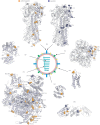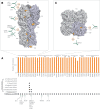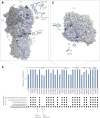Genome-Wide Analysis of Evolutionary Markers of Human Influenza A(H1N1)pdm09 and A(H3N2) Viruses May Guide Selection of Vaccine Strain Candidates
- PMID: 26615216
- PMCID: PMC4700966
- DOI: 10.1093/gbe/evv240
Genome-Wide Analysis of Evolutionary Markers of Human Influenza A(H1N1)pdm09 and A(H3N2) Viruses May Guide Selection of Vaccine Strain Candidates
Abstract
Here we analyzed whole-genome sequences of 3,969 influenza A(H1N1)pdm09 and 4,774 A(H3N2) strains that circulated during 2009-2015 in the world. The analysis revealed changes at 481 and 533 amino acid sites in proteins of influenza A(H1N1)pdm09 and A(H3N2) strains, respectively. Many of these changes were introduced as a result of random drift. However, there were 61 and 68 changes that were present in relatively large number of A(H1N1)pdm09 and A(H3N2) strains, respectively, that circulated during relatively long time. We named these amino acid substitutions evolutionary markers, as they seemed to contain valuable information regarding the viral evolution. Interestingly, influenza A(H1N1)pdm09 and A(H3N2) viruses acquired non-overlapping sets of evolutionary markers. We next analyzed these characteristic markers in vaccine strains recommended by the World Health Organization for the past five years. Our analysis revealed that vaccine strains carried only few evolutionary markers at antigenic sites of viral hemagglutinin (HA) and neuraminidase (NA). The absence of these markers at antigenic sites could affect the recognition of HA and NA by human antibodies generated in response to vaccinations. This could, in part, explain moderate efficacy of influenza vaccines during 2009-2014. Finally, we identified influenza A(H1N1)pdm09 and A(H3N2) strains, which contain all the evolutionary markers of influenza A strains circulated in 2015, and which could be used as vaccine candidates for the 2015/2016 season. Thus, genome-wide analysis of evolutionary markers of influenza A(H1N1)pdm09 and A(H3N2) viruses may guide selection of vaccine strain candidates.
Keywords: evolutionary markers; influenza vaccine; influenza virus; virus evolution.
© The Author(s) 2015. Published by Oxford University Press on behalf of the Society for Molecular Biology and Evolution.
Figures





References
-
- Broberg E, et al. 2015. Start of the 2014/15 influenza season in Europe: drifted influenza A(H3N2) viruses circulate as dominant subtype. Euro Surveill. 20:21023. - PubMed
-
- Corti D, et al. 2011. A neutralizing antibody selected from plasma cells that binds to group 1 and group 2 influenza A hemagglutinins. Science 333:850–856. - PubMed
Publication types
MeSH terms
Substances
LinkOut - more resources
Full Text Sources
Other Literature Sources
Medical
Miscellaneous

